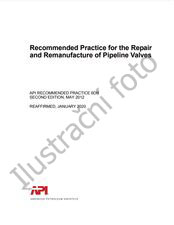Potřebujeme váš souhlas k využití jednotlivých dat, aby se vám mimo jiné mohly ukazovat informace týkající se vašich zájmů. Souhlas udělíte kliknutím na tlačítko „OK“.

API PUBL 4628-ed.1996
Guidance Manual for Modeling Hypothetical Accidental Releases to the Atmosphere
Přeložit název
NORMA vydána dne 1.11.1996
Informace o normě:
Označení normy: API PUBL 4628-ed.1996
Datum vydání normy: 1.11.1996
Kód zboží: NS-1139796
Počet stran: 212
Přibližná hmotnost: 667 g (1.47 liber)
Země: Americká technická norma
Kategorie: Technické normy API
Anotace textu normy API PUBL 4628-ed.1996 :
API PUBL 4628, 1996 Edition, November 1996 - Guidance Manual for Modeling Hypothetical Accidental Releases to the Atmosphere
The purpose of this Guidance Manual is to provide methodologies for consequence analysis purposes. That is, given a potential or after-the-fact set of circumstances for the accidental release of a chemical fluid into the atmosphere (the "scenario"), what are the appropriate methods to estimate spatial and time dependent concentrations of the material over a particular geographical area?
Scenarios may be generated within the hazard analysis parts of overall risk assessment studies. Techniques such as HAZOPS, fault tree, and "what if" analyses are used to discover potential hazardous situations which lead to an accidental release. Concentrations predicted for an identified release scenario may then be used to estimate possible impact of the shock waves and thermal damage from vapor cloud explosions, or potential toxic effects. The impact of toxic dispersed vapor clouds requires interpretation by specialists such as toxicologists and industrial hygienists. Thus the person or persons doing the source/release and dispersion modeling must interact "upstream" with those doing hazard analyses and with those "downstream" who interpret health or flammability aspects.
The modeling methodologies presented and recommended are intended for use in risk assessment studies for refinery/chemical plants during design or operation as well as for emergency response planning purposes. Also, available quantitative or semi-quantitative methods for mitigating a release after or during its occurrence are discussed. The product of any modeling exercise is an estimate of concentrations of the released material over a potentially affected geographic area so that possible toxic and/or flammability impact can be estimated. Modeling procedures are recommended on the basis of applicability to the particular situation being considered, required accuracy of results, simplicity, and availability of computer codes. If comparable modeling methods are available, they are discussed and used selectively in the example release scenarios. The calculational procedures and computer programs discussed are in the public domain. To limit the extent of the demonstrative simulation work, only SLAB, HGSYSTEM and DEGADIS program systems were used.
The release/dispersion scenarios described and exemplified are hypothetical; that is, they do not describe any particular accident that has occurred, nor a known situation for which an accident is liable to occur. However, the treatment and examples are realistic, for they have been drawn from the experience and knowledge of many technical personnel working in industry, government and academia. Calculational procedures used and recommended are well-accepted and are state-of-the-art in terms of readily available methods in the public domain; for example, the calculations for initial fluid release amount/flow rate and its concomitant physical state use standard chemical engineering methods, including thermodynamic and physical property estimation. Additionally, the turbulent jet and dense gas atmospheric dispersion models are based on atmospheric boundary layer theory and other physical principles; the models have been extensively evaluated against small and large scale experiments.
This Manual does not cover the origination of release scenarios, nor the interpretation of concentration estimates, except to demonstrate the concepts. These factors should be established separately for each individual modeling application. Effects criteria, such as flammability limits and references to toxic materials, toxicities, or toxic concentrations levels, (concentration of concern), are used only to impart a sense of reality to the various examples and should not be used without review. Estimation and/or interpretation of possible toxic effects of model-predicted chemical concentrations are outside the scope and purpose of this Manual. The sidebar suggests a method for selection of flammability limit concentrations if no other information is available and/or for screening purposes.
The scope of the manual does not include model development and evaluation. Use of a specific modeling program for a type of application does not imply that program is particularly recommended. In general, problems encountered by the author in using a program were made known to the program author.
Manual Organization
Chapter 2 of the Manual provides an overview of phenomena which must be considered in defining release/dispersion scenarios. The phenomena involved are discussed qualitatively so that the applicability of modeling methods described in later chapters can be appreciated. Eight representative scenarios are described for the purpose of previewing types of problems, which will be analyzed, simulated and discussed in Chapter 6.
Chapter 3 provides working methods for estimating the rates and physical states of released substances on entering the atmosphere. Because chemical engineering thermodynamics is extensively used, a working overview to this subject provides the basic concepts involved, as well as references to sources of physical and thermodynamic data required for the calculations. Calculational methods follow for releases from process equipment (valves, openings in vessel walls, sudden vessel failure, etc.). The releases may form "clouds" consisting of vapor, and vapor plus liquid aerosols. In some cases, evaporating pools of liquids may be formed on
Doporučujeme:
Aktualizace technických norem
Chcete mít jistotu, že používáte pouze platné technické normy?
Nabízíme Vám řešení, které Vám zajistí měsíční přehled o aktuálnosti norem, které používáte.
Chcete vědět více informací? Podívejte se na tuto stránku.



 Cookies
Cookies
